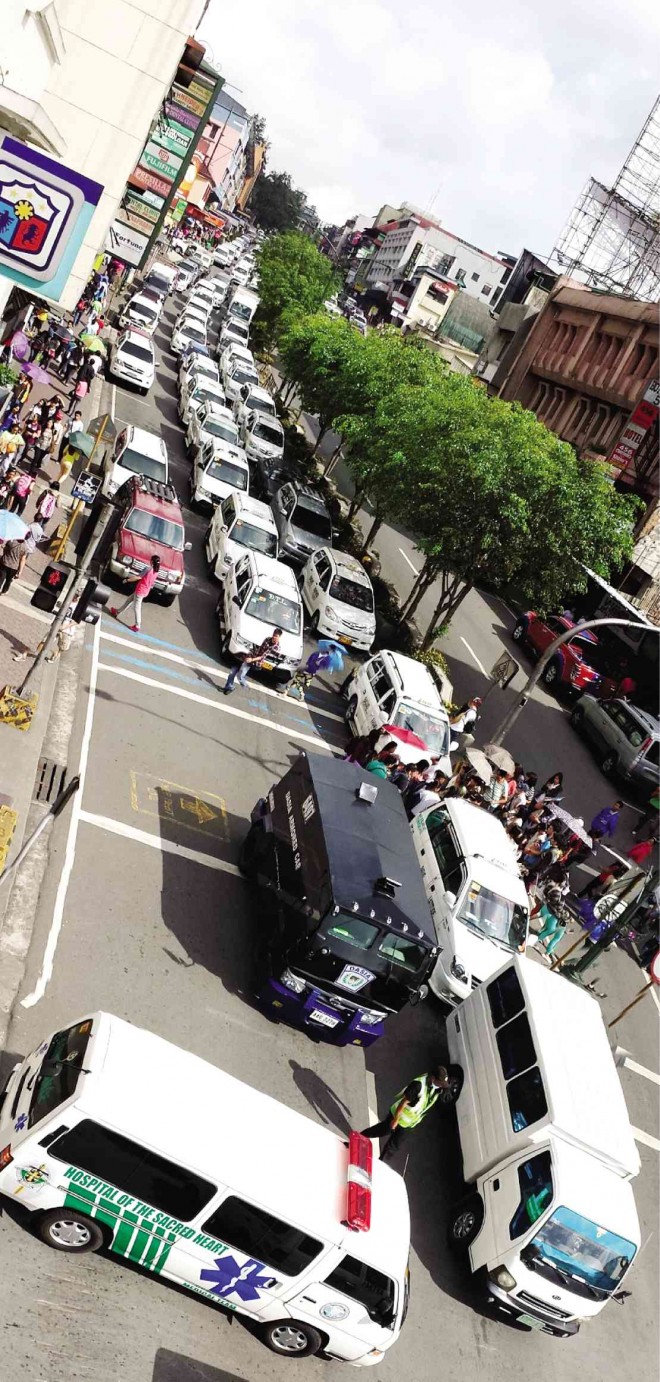Cost of dirty air in Baguio due to traffic put at P77M

DOWNTOWN BLUES Heavy traffic characterizes downtown Session Road in Baguio City every day, exposing so many people to pollution. Some residents have advocated a ban on vehicles driving through downtown to reduce smog. Others have proposed building an alternative mass transport system such as an elevated train powered by electricity. EV ESPIRITU/INQUIRER NORTHERN LUZON
BAGUIO CITY—Remember that joke about a patient who died after receiving his hospital bill for treating his illness? Policymakers should take it seriously when they dismiss traffic grid-locks in town centers as “happy problems” due to the business these vehicles presumably bring to local economies.
In downtown Baguio, at least, the cost of constantly breathing in bad air due to pollution expelled by vehicles crawling in gridlocks is P77 million, according to University of the Philippines economists who computed the peso value of illnesses attributed to elevated levels of particulate matter (PM) to which urban dwellers are exposed.
Achilles Costales, a UP Baguio economics professor, and Maria Angeles Catelo, an environmental economist teaching at UP Los Baños, said that when a child suffers asthma attacks or an adult dies from upper respiratory tract infection, their families end up shouldering a combined P77.39 million in expenditures and lost economic opportunities annually.
They said the quality of downtown Baguio air from 2007 to 2012 had been tainted with 83 µg per m3 (micrograms per cubic meter) of small particulates (PM10).
Dr. Donabel Tubera, who heads the Baguio health department’s (BHD) epidemiology and surveillance unit, said the UP team’s findings provided the “connective tissue” linking pollution to heavy economic consequences unless policymakers make changes in mass transportation, traffic management and pollution controls.
Article continues after this advertisementHealth risks
Article continues after this advertisement“This is proof that health risks can obstruct economic development,” Tubera said at the Sept. 14 UP Baguio forum where Costales and Catelo presented their study.
Costales said Philippine pollution standards that define when air pollution becomes a critical health risk (60 µg per m3) are “too lax,” when compared with the World Health Organization’s standard of 20 µg per m3.
Air pollutants in downtown Baguio are a combination of microscopic sulfates, nitrates, ammonia, sodium chloride, black carbon and dust that harm people when inhaled in heavy concentrations.
“Notwithstanding the practical policy standards set [by the government and WHO], there is unanimity in the epidemiological community that there is no scientifically validated safe level of exposure to PM10, nor to fine particulates (PM2.5) in the air,” Costales and Catelo said.
Their team surveyed 398 families living within a 1.5-kilometer radius from Baguio’s central business district (the row of shops and restaurants from the city market up to Luneta Hill, which now hosts a shopping mall). They also studied medical cases involving asthma and other respiratory diseases recorded by the BHD and public hospitals in the city.
Taking their cue from the WHO standard, they calculated the cost of treatment or hospital care for ailing family members, the foregone earnings of the patients and the people who take care of them, and the productivity lost when a family member dies from a disease attributed to air pollution.
Costales said the group premised its cost evaluation of pollution-related ailments on what families could have saved had the country applied WHO pollution standards and regulations.
The P77.39 million represents the cost of premature mortality (or early deaths due to pollution-related ailments) and the cost of medicating these illnesses, while the P53.35 million a year is the sum of the lost income and productivity of people who died from respiratory ailments which the surveyed households could have avoided.
Based on 157 mortality cases recorded by BHD in 2014, each fatality represented P337,550 in revenue he or she could have generated had the patient been healthy enough to complete his or her average productive years until age 65, the study said.
The cost analysis took into account the city’s daily minimum-wage level of P280.
Costales said P24.04 million was the “value saved from avoiding what was otherwise attributable cases of illnesses.” This amount would be spent on hospital admission, out-patient consultations and medication.
For example, a patient spends P34,214 a year for treatment of hypertension or cardiovascular disease. Patients who suffered this ailment ended up spending P4.3 million a year, the working paper says.
The monetary value of the cost of pollution on health is lower at P32.4 million when set against standards for what the Philippines considers permissible pollution exposure, Costales said.
Health records could be understated, the team acknowledged. The survey results suggested that most of the households self-medicate instead of spend for hospital diagnosis or treatment.